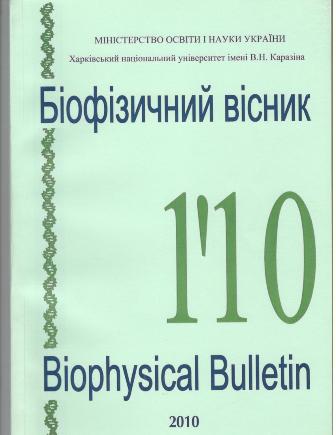Cytochrome c – cardiolipin interactions: extended lipid anchorage revisited
Abstract
Resonance energy transfer (RET) from antrylvinyl-labeled (AV) lipids to the heme moiety of cytochrome c (cyt
c) has been employed to assess the molecular level details of cyt c interactions with negatively charged lipid
membranes composed of phosphatidylcholine (PC) and its mixture with 10 or 20 mol % of cardiolipin (CL). At
the lowest ionic strength used here (20 mM) RET profiles from neutral (AV-PC) and anionic (AV-CL) donor
were virtually indistinguishable, suggesting that the peculiarities of cyt c association with lipid membranes
containing different donors are identical. In contrast, elevating ionic strength up to 40 and 60 mM resulted in
an expected decrease of energy transfer efficiency in the case of AV-PC containing liposomes, but not for those with AV-CL where RET exhibited an unexpected enhancement with increasing ionic strength. Monte Carlo analysis of the results obtained allowed us to attribute this untypical behavior to the transition of CL into extended lipid conformation. The revealed peculiarities of cyt c – CL interactions are of great interest not only from the viewpoint of regulating cyt c electron transfer and apoptotic propensities but also for elucidating the general mechanisms by which membrane functional activities can be modulated by protein-lipid interactions.
Downloads
References
2. V. M. Trusova et al. // J. Fluoresc. 2009. V. 19. P. 1017-1023.
3. F. Sinibaldi et al. // Biochemistry. 2008. V. 47. P. 6928-6935.
4. Z. Schug et al. // Biochim. Biophys. Acta. 2009. V. 1788. P. 2022-2031.
5. D. Ostrander et al. // J. Biol. Chem. 2001. V. 276. P. 38061-38067.
6. T. Pinheiro et al. // J. Mol. Biol. 2003. V. 303. P. 617-626.
7. S. Bernard et al. // Biophys. J. 2004. V. 86. P. 3863-3872.
8. E. Choi et al. // Biophys. J. 2004. V. 87. P. 3234-3241.
9. G. Gorbenko et al. // Biophys. J. 2006. V. 90. P. 4093-4103.
10. E. Kalanxhi et al. // Biochem. J. 2007. V.407. P. 179-187.
11. L. Bergelson et al. // Chem. Phys. Lipids. 1985. V. 37. P. 165-195.
12. G. Gorbenko et al. // Biochim. Biophys. Acta. 2009. V. 1788. P. 1358-1365.
13. M. Rytömaa et al. // J. Biol. Chem. 1994. V. 269. P. 1770-1774.
14. M. Rytömaa et al. // J. Biol. Chem. 1995. V. 270. P. 3197-3202.
Authors who publish with this journal agree to the following terms:
- Authors retain copyright and grant the journal right of first publication with the work simultaneously licensed under a Creative Commons Attribution License that allows others to share the work with an acknowledgement of the work's authorship and initial publication in this journal.
- Authors are able to enter into separate, additional contractual arrangements for the non-exclusive distribution of the journal's published version of the work (e.g., post it to an institutional repository or publish it in a book), with an acknowledgement of its initial publication in this journal.
- Authors are permitted and encouraged to post their work online (e.g., in institutional repositories or on their website) prior to and during the submission process, as it can lead to productive exchanges, as well as earlier and greater citation of published work (See The Effect of Open Access).





